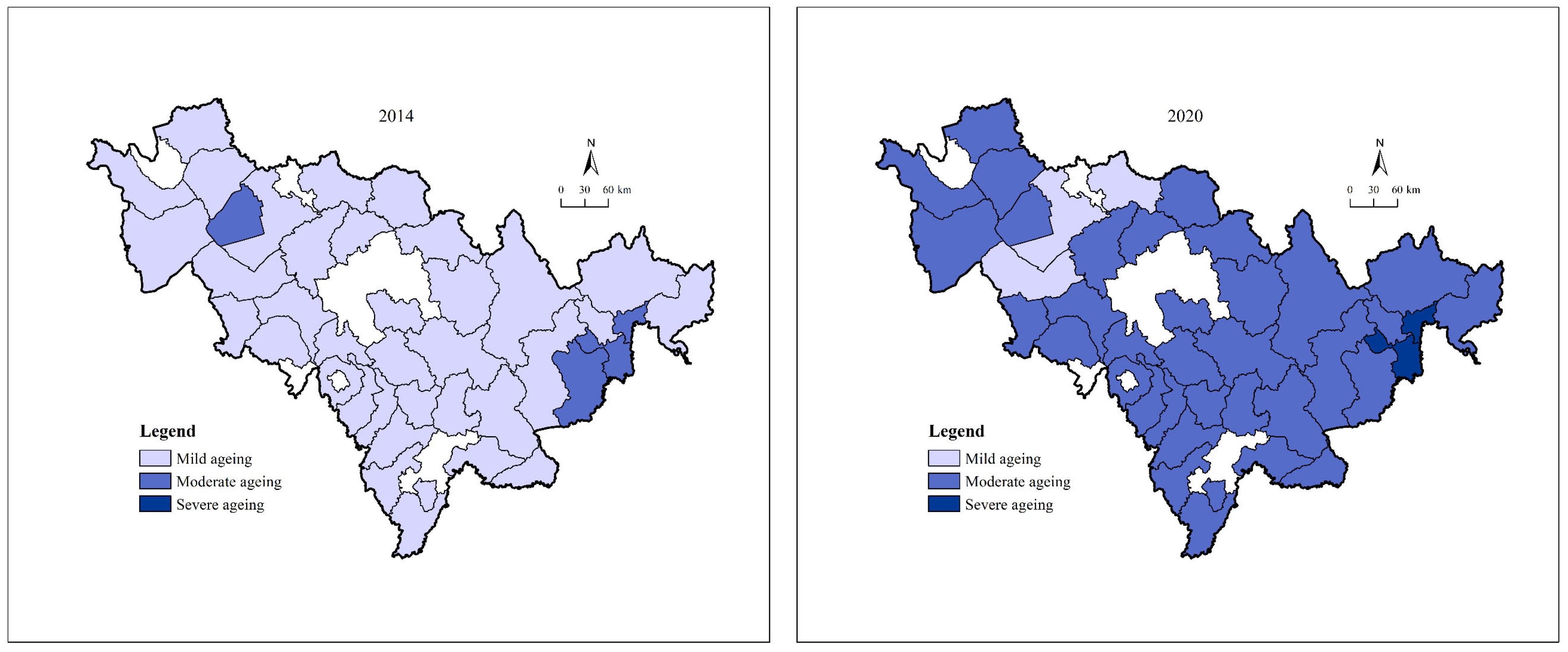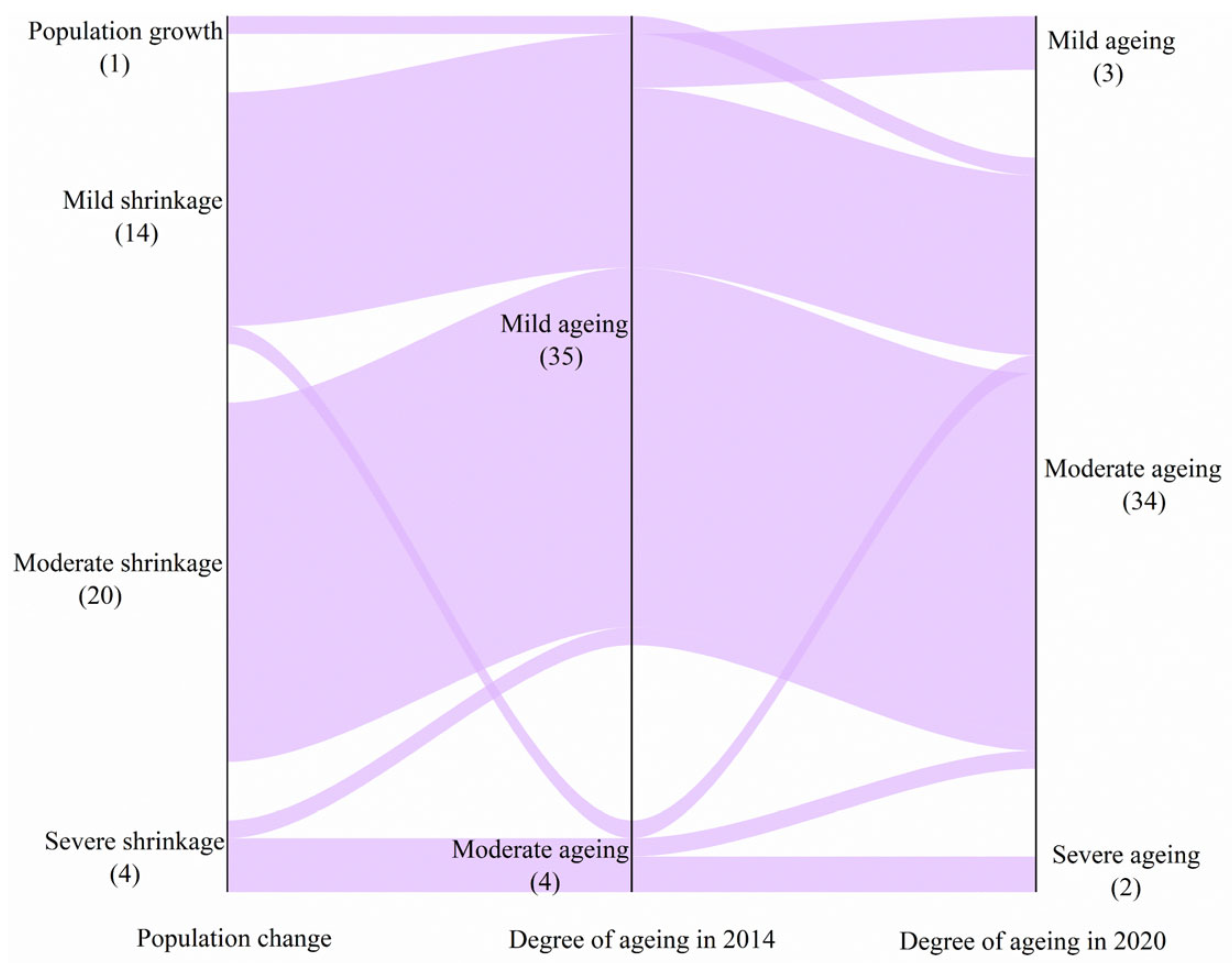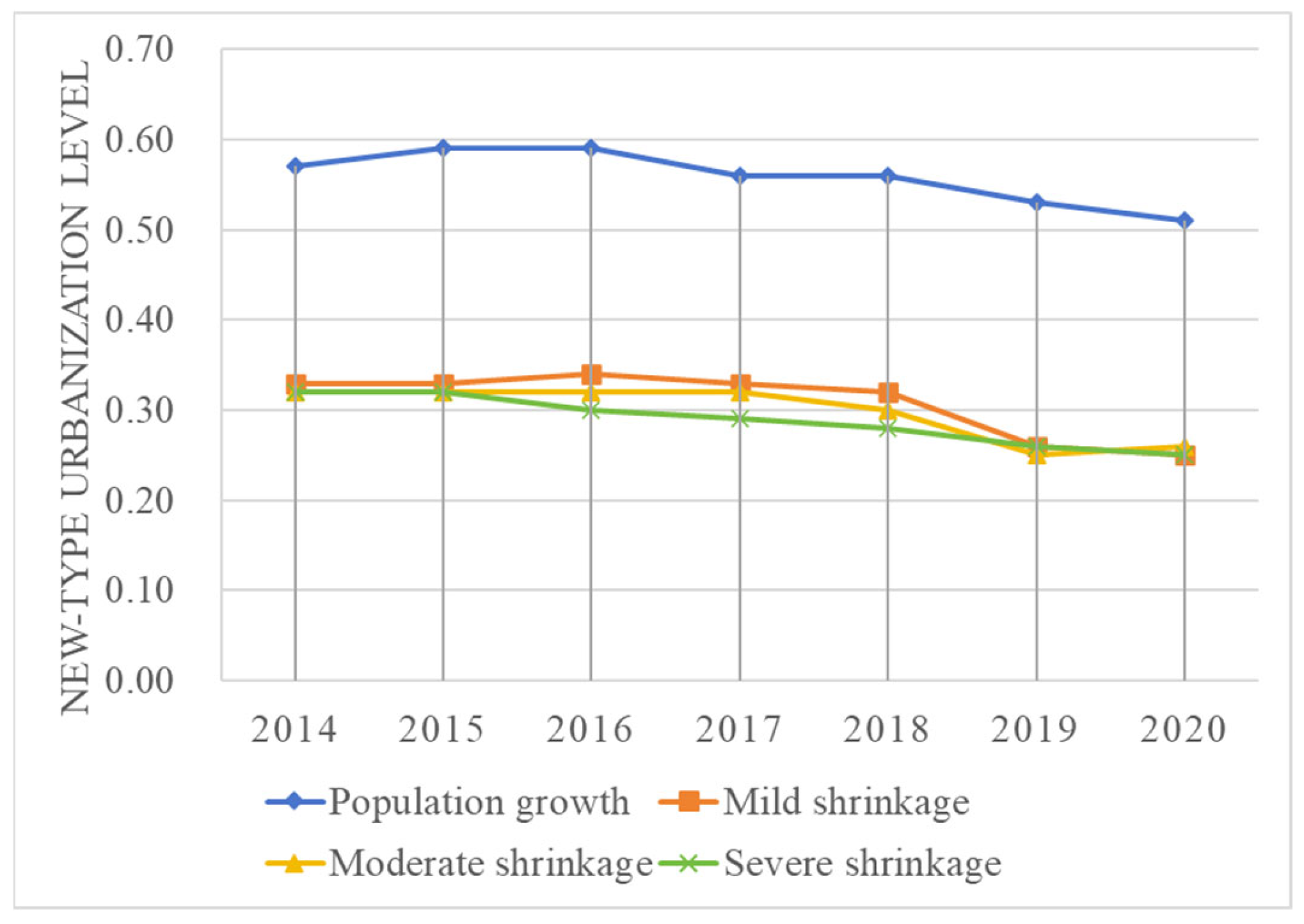The Relationship Between Population Shrinkage, Ageing, and New-Type Urbanization in Counties: The Case of Jilin Province, China
Abstract
1. Introduction
2. Literature Review
2.1. Theory of New-Type Urbanization
2.2. Measuring New-Type Urbanization
2.3. Research Scale of New-Type Urbanization
2.4. New-Type Urbanization, Population Shrinkage, and Ageing
3. Study Area and Methods
3.1. Study Area
3.2. Methods
3.2.1. CRITIC
3.2.2. The Calculation of the Level of New-Type Urbanization
3.2.3. Measurement of Population Shrinkage
3.2.4. Measurement of Ageing
3.2.5. Bivariate Spatial Autocorrelation
3.3. Index System
3.4. Data Sources and Processing
4. Results
4.1. Spatio-Temporal Patterns of Population Shrinkage and Ageing in Counties
4.1.1. Population Shrinkage
4.1.2. Ageing
4.1.3. Relationship Between Population Change and Ageing
4.2. Spatio-Temporal Patterns of New-Type Urbanization Levels in Counties
4.3. Relationship Between Population Shrinkage, Ageing, and New-Type Urbanization
5. Discussion
6. Conclusions
Author Contributions
Funding
Data Availability Statement
Conflicts of Interest
References
- Zhang, J.; Wang, G.; Li, J.; Lu, Q. Population changes in urbanization progress and the influence on land use in Suizhou City. Prog. Geogr. 2004, 23, 87–96. (In Chinese) [Google Scholar]
- Cao, G.; Liu, T. Rising role of inland regions in China’s urbanization in the 21st century: The new trend and its explanation. Acta Geogr. Sin. 2011, 66, 1631–1643. (In Chinese) [Google Scholar]
- Lu, D.; Chen, M. Several viewpoints on the background of compiling the “National New Urbanization Planning (2014–2020)”. Acta Geogr. Sin. 2015, 70, 179–185. (In Chinese) [Google Scholar]
- Chen, M.; Liu, W.; Lu, D.; Chen, H.; Ye, C. Progress of China’s new-type urbanization construction since 2014: A preliminary assessment. Cities 2018, 78, 180–193. [Google Scholar] [CrossRef]
- Jarzebski, M.P.; Elmqvist, T.; Gasparatos, A.; Fukushi, K.; Eckersten, S.; Haase, D.; Goddness, J.; Khoshkar, S.; Saito, O.; Takeuchi, K.; et al. Ageing and population shrinking: Implications for sustainability in the urban century. Npj Urban Sustain. 2021, 1, 17. [Google Scholar] [CrossRef]
- Dorigo, G.; Tobler, W. Push-Pull Migration Laws. Ann. Assoc. Am. Geogr. 1983, 73, 1–17. [Google Scholar] [CrossRef]
- Majelantle, R.G.; Navaneetham, K. Migration and fertility: A review of theories and evidences. J. Glob. Econ. 2013, 1, 1000101. [Google Scholar] [CrossRef]
- Chaudhuri, S.; Mukhopadhyay, U. The Harris–Todaro Migration Model and Introduction of the Informal Sector. In Revisiting the Informal Sector; Springer: New York, NY, USA, 2010. [Google Scholar]
- Ghosh, D. The metamorphosis of Lewis’s dual economy model. J. Econ. Methodol. 2007, 14, 5–25. [Google Scholar] [CrossRef]
- Yan, D.; Sun, W.; Li, P.; Liu, C.; Li, Y. Effects of economic growth target on the urban–rural income gap in China: An empirical study based on the urban bias theory. Cities 2025, 156, 105518. [Google Scholar] [CrossRef]
- Bai, X.; Shi, P.; Liu, Y. Society: Realizing China’s urban dream. Nature 2014, 509, 158–160. [Google Scholar] [CrossRef] [PubMed]
- Chen, M.; Liu, W.; Lu, D. Challenges and the way forward in China’s new-type urbanization. Land Use Policy 2016, 55, 334–339. [Google Scholar] [CrossRef]
- Deng, B.; Zhong, F. Leading or constraining? Development of new-type urbanization under economic growth targets. Land 2023, 12, 916. [Google Scholar] [CrossRef]
- Chen, M.; Gong, Y.; Lu, D.; Ye, C. Build a people-oriented urbanization: China’s new-type urbanization dream and Anhui model. Land Use Policy 2016, 80, 1–9. [Google Scholar] [CrossRef]
- Huang, M.; Guo, Q.; Zhang, G.; Tang, Y.; Wu, X. Spatiotemporal coupling of new-type urbanization and ecosystem services in the Huaihe River Basin, China: Heterogeneity and regulatory strategy. Land 2025, 14, 286. [Google Scholar] [CrossRef]
- Yu, Y.; Zhao, K.; Du, Y. Nexus between new-type urbanization, economic development, and haze pollution in China: A spatial analysis. J. Urban Plan. Dev. 2024, 150, 04024043. [Google Scholar] [CrossRef]
- Nichol, J.E.; King, B.; Ding, X.L. Sustainable urbanization. Int. J. Remote Sens. 2013, 34, 755–758. [Google Scholar] [CrossRef]
- Chen, M.; Liu, W.; Tao, X. Evolution and assessment on China’s urbanization 1960–2010: Under-urbanization or over-urbanization? Habitat Int. 2013, 38, 25–33. [Google Scholar] [CrossRef]
- Mulligan, G.F. Revisiting the urbanization curve. Cities 2013, 32, 113–122. [Google Scholar] [CrossRef]
- Yang, X. China’s rapid urbanization. Science 2013, 342, 310. [Google Scholar] [CrossRef]
- Yang, D.F.; Yin, C.Z.; Long, Y. Urbanization and sustainability in China: An analysis based on the urbanization Kuznets-curve. Plan. Theory 2013, 12, 391–405. [Google Scholar] [CrossRef]
- Merrifield, A. The urban question under planetary urbanization. Int. J. Urban Reg. Res. 2013, 37, 909–922. [Google Scholar] [CrossRef]
- Chen, M.; Zhou, Y.; Huang, X.; Ye, C. The integration of new-type urbanization and rural revitalization strategies in China: Origin, reality and future trends. Land 2021, 10, 207. [Google Scholar] [CrossRef]
- Cao, N.; Ling, S.; Cui, X. Measurement and comparative analysis of Chinese new-type urbanization and eco-environment system coordination. Sustainability 2025, 17, 1824. [Google Scholar] [CrossRef]
- Li, P.; Li, T. Spatiotemporal analysis of ecosystem services and the impact of new-type urbanization: A case study of Chengdu, China. Ecol. Indic. 2025, 171, 113191. [Google Scholar] [CrossRef]
- Lin, B.; Zhu, J. Impact of new-type urbanization on energy intensity: A city-level analysis. Energy Econ. 2021, 99, 105292. [Google Scholar] [CrossRef]
- Liu, J.; Ma, X.; Jia, W.; Zhang, S. Can new-type urbanization construction narrow the urban-rural income gap? Evidence from China. Sustainability 2022, 14, 14725. [Google Scholar] [CrossRef]
- Lu, Y.; Song, W.; Lyu, Q. Assessing the effects of the new-type urbanization policy on rural settlement evolution using a multiagent model. Habitat Int. 2022, 127, 102622. [Google Scholar] [CrossRef]
- Ma, H.; Wang, K.; Fang, C. How does new-type urbanization promote green development efficiency in China? The mediating role of governments, enterprises, and residents. J. Environ. Manag. 2025, 6, 100241. [Google Scholar] [CrossRef]
- Meng, Y.; Hao, Z.; Shang, S. Analysis of the equalization effect of basic public services in new-type urbanization: A case study of county regions in Guizhou, China. Heliyon 2024, 10, e39922. [Google Scholar] [CrossRef]
- Wang, J.; Han, S.; Lin, H.; Wu, P.; Yuan, J. New-type urbanization ecologically reshaping China. Heliyon 2023, 9, e12925. [Google Scholar] [CrossRef]
- Xia, Q.; Tian, G.; Zhao, D.; Zhao, Q.; Varis, O. Effects of new-type urbanization on resource pressure: Evidence from a water-energy-food system perspective in China. Sustain. Cities Soc. 2024, 107, 105411. [Google Scholar] [CrossRef]
- Xiao, Y.; Huang, H.; Qian, X.; Zhang, L.; An, B. Can new-type urbanization reduce urban building carbon emissions? New evidence from China. Sustain. Cities Society 2023, 90, 104410. [Google Scholar] [CrossRef]
- Wang, Y.; Geng, Q.; Si, X.; Kan, L. Coupling and coordination analysis of urbanization, economy and environment of Shandong Province, China. Environ. Dev. Sustain. 2021, 23, 10397–10415. [Google Scholar] [CrossRef]
- Wang, Y.; Wang, L. New-type urbanization and rural revitalization: A study on the coupled development of the Yangtze River Economic Belt, China. PLoS ONE 2025, 20, e0314724. [Google Scholar] [CrossRef]
- Yu, J.; Hu, W.; Hou, L. Towards more resilient cities—Analyzing the impact of new-type urbanization on urban resilience: Considering spatial spillover boundaries. Sustain. Cities Soc. 2024, 114, 105735. [Google Scholar] [CrossRef]
- Yuan, C.; Zhang, B.; Xu, J.; Lyu, D.; Liu, J.; Hu, Z.; Han, Y. Impact of new-type urbanization pilot policy on public service provision: Evidence from China. Cities 2025, 161, 105853. [Google Scholar] [CrossRef]
- Zhang, Q.; Kong, Q.; Zhang, M.; Huang, H. New-type urbanization and ecological wellbeing performance: A coupling coordination analysis in the middle reaches of the Yangtze River urban agglomerations, China. Ecol. Indic. 2024, 159, 111678. [Google Scholar] [CrossRef]
- Zhang, S.; Huang, C.; Li, X.; Song, M. The spatial-temporal evolution and influencing factors of the coupling coordination of new-type urbanization and ecosystem services value in the Yellow River Basin. Ecol. Indic. 2024, 166, 112300. [Google Scholar] [CrossRef]
- Zhou, R.; Guo, Y.; Wu, Y. Exploration on the innovation model of county urbanization development with the resource constraints in China. Sustainability 2023, 15, 16129. [Google Scholar] [CrossRef]
- UN. Population Dynamics. World Population Dynamics. World Population Prospects 2019 Revision; United Nations: New York, NY, USA, 2019. [Google Scholar]
- UN. World Population Ageing 2019: Highlights; United Nations: New York, NY, USA, 2019. [Google Scholar]
- Bricker, D.; Ibbitson, J. Empty Planet: The Shock of Global Population Decline; Random House Audio: Woodland Hills, CA, USA, 2019. [Google Scholar]
- De Sherbinin, A.; Carr, D.; Cassels, S.; Jiang, L. Population and environment. Annu. Rev. Environ. Resour. 2007, 32, 345–373. [Google Scholar] [CrossRef]
- Wang, L.; Yuan, M.; Li, H.; Chen, X. Exploring the coupling coordination of urban ecological resilience and new-type urbanization: The case of China’s Chengdu–Chongqing Economic Circle. Environ. Technol. Innov. 2023, 32, 103372. [Google Scholar] [CrossRef]
- Xie, M.; Feng, Z.; Guan, H.; Hao, F.; Wang, S.; Chang, X. Population shrinkage and its influence on housing prices: A mediation perspective based on commercial amenities. Habitat Int. 2024, 151, 103151. [Google Scholar] [CrossRef]
- Gao, W.; Yang, L.; Zhao, X.; Li, T. Spatiotemporal patterns and influencing factors of population shrinkage in the Yellow River Basin from the perspective of the Major Function Oriented Zone. Geogr. Res. 2025, 44, 1565–1586. (In Chinese) [Google Scholar]
- Wang, H.; Chen, H. Aging in China: Challenges and Opportunities. China CDC Wkly 2022, 4, 601–602. [Google Scholar]
- Yang, J.; Huang, X. The 30m annual land cover datasets and its dynamics in China from 1985 to 2023. Earth Syst. Sci. Data 2024, 13, 3907–3925. [Google Scholar] [CrossRef]
- Zou, Y.; Zhu, X.; Pu, C. Four decades of population expansion and shrinkage across Chinese cities. Environ. Plan. B-Urban Anal. City Sci. 2025, 52, 1271–1274. [Google Scholar] [CrossRef]
- Li, H.; Lo, K.; Zhang, P. Population shrinkage in resource-dependent cities in China: Processes, patterns and drivers. Chin. Geogr. Sci. 2019, 30, 1–15. [Google Scholar] [CrossRef]
- Ao, R.; Chang, L. Influencing mechanism of regional ageing in China based on the Structural Equation Model. Acta Geogr. Sin. 2020, 75, 1572–1584. (In Chinese) [Google Scholar]







| Primary Indicators | Secondary Indicators | Weighting | Standard Deviation | Conflict | Information |
|---|---|---|---|---|---|
| Population | Proportion of urban population in total population (%) | 7.24% | 0.24 | 15.91 | 3.82 |
| Proportion of employees in the secondary and tertiary industries (%) | 3.84% | 0.14 | 14.49 | 2.02 | |
| Economy | Per capita GDP (Yuan per person) | 6.13% | 0.22 | 14.48 | 3.23 |
| Proportion of the secondary and tertiary industries in GDP (%) | 5.53% | 0.19 | 15.00 | 2.92 | |
| Total retail sales of consumer goods (CNY ten thousand) | 5.53% | 0.21 | 14.16 | 2.92 | |
| Fixed-asset investment growth rate (%) | 3.56% | 0.11 | 17.30 | 1.88 | |
| Number of enterprises of designated size (units) | 6.53% | 0.22 | 15.35 | 3.44 | |
| Society | Proportion of general public service expenditure (%) | 4.74% | 0.15 | 17.14 | 2.50 |
| Per capita disposable annual income of urban households (Yuan per person) | 4.64% | 0.14 | 17.45 | 2.45 | |
| Total number of schools of all types and levels (units) | 8.59% | 0.24 | 18.72 | 4.53 | |
| Number of beds in medical and health institutions (units) | 5.37% | 0.18 | 15.99 | 2.84 | |
| Number of urban residents receiving minimum living allowances (persons) | 5.46% | 0.15 | 18.99 | 2.88 | |
| Participation rate in basic pension insurance for urban employees (%) | 6.28% | 0.21 | 15.90 | 3.31 | |
| Total number of books and periodicals in the library (thousands) | 5.54% | 0.19 | 15.16 | 2.93 | |
| Percentage of public safety expenditure (%) | 5.20% | 0.17 | 16.32 | 2.74 | |
| Land | Urban construction land development speed (%) | 4.84% | 0.15 | 17.51 | 2.56 |
| Urban construction land development intensity (%) | 4.31% | 0.15 | 14.66 | 2.27 | |
| Environment | Percentage of expenditure on energy conservation and protection (%) | 3.38% | 0.10 | 17.30 | 1.78 |
| Number of sewage treatment plants (units) | 3.29% | 0.10 | 16.65 | 1.74 |
| Counties | 2014 | 2015 | 2016 | 2017 | 2018 | 2019 | 2020 |
|---|---|---|---|---|---|---|---|
| Antu | 0.28 | 0.28 | 0.26 | 0.26 | 0.25 | 0.24 | 0.24 |
| Changbai | 0.35 | 0.34 | 0.33 | 0.35 | 0.33 | 0.28 | 0.31 |
| Changling | 0.33 | 0.33 | 0.35 | 0.35 | 0.32 | 0.23 | 0.22 |
| Daan | 0.28 | 0.27 | 0.27 | 0.27 | 0.25 | 0.18 | 0.23 |
| Dehui | 0.42 | 0.40 | 0.37 | 0.38 | 0.36 | 0.26 | 0.27 |
| Dongfeng | 0.33 | 0.34 | 0.32 | 0.32 | 0.32 | 0.26 | 0.24 |
| Dongliao | 0.27 | 0.27 | 0.27 | 0.27 | 0.23 | 0.25 | 0.22 |
| Dunhua | 0.40 | 0.41 | 0.38 | 0.38 | 0.32 | 0.33 | 0.32 |
| Fusong | 0.36 | 0.36 | 0.38 | 0.41 | 0.42 | 0.36 | 0.33 |
| Fuyu | 0.34 | 0.34 | 0.35 | 0.34 | 0.32 | 0.24 | 0.22 |
| Gongzhuling | 0.40 | 0.41 | 0.43 | 0.45 | 0.43 | 0.37 | 0.36 |
| Helong | 0.33 | 0.35 | 0.32 | 0.29 | 0.26 | 0.25 | 0.23 |
| Huadian | 0.38 | 0.39 | 0.39 | 0.40 | 0.35 | 0.27 | 0.27 |
| Huinan | 0.28 | 0.29 | 0.29 | 0.28 | 0.26 | 0.23 | 0.24 |
| Hunchun | 0.39 | 0.39 | 0.42 | 0.43 | 0.40 | 0.36 | 0.36 |
| Ji’an | 0.29 | 0.30 | 0.31 | 0.29 | 0.27 | 0.26 | 0.25 |
| Jiaohe | 0.36 | 0.36 | 0.37 | 0.34 | 0.33 | 0.24 | 0.25 |
| Jingyu | 0.32 | 0.31 | 0.29 | 0.29 | 0.29 | 0.28 | 0.28 |
| Linjiang | 0.33 | 0.34 | 0.35 | 0.35 | 0.34 | 0.32 | 0.31 |
| Lishu | 0.28 | 0.27 | 0.27 | 0.27 | 0.26 | 0.23 | 0.21 |
| Liuhe | 0.30 | 0.29 | 0.27 | 0.25 | 0.25 | 0.22 | 0.22 |
| Longjing | 0.29 | 0.28 | 0.26 | 0.26 | 0.25 | 0.24 | 0.23 |
| Meihekou | 0.35 | 0.39 | 0.42 | 0.43 | 0.44 | 0.39 | 0.37 |
| Nongan | 0.34 | 0.34 | 0.35 | 0.35 | 0.33 | 0.23 | 0.22 |
| Panshi | 0.33 | 0.34 | 0.37 | 0.35 | 0.36 | 0.27 | 0.28 |
| Qian’an | 0.33 | 0.36 | 0.32 | 0.30 | 0.29 | 0.21 | 0.21 |
| Qianguo | 0.35 | 0.35 | 0.38 | 0.38 | 0.36 | 0.26 | 0.25 |
| Shuangliao | 0.30 | 0.29 | 0.27 | 0.25 | 0.24 | 0.24 | 0.24 |
| Shulan | 0.30 | 0.31 | 0.30 | 0.29 | 0.28 | 0.19 | 0.18 |
| Taonan | 0.27 | 0.25 | 0.24 | 0.24 | 0.23 | 0.19 | 0.20 |
| Tonghua | 0.33 | 0.31 | 0.33 | 0.31 | 0.31 | 0.23 | 0.26 |
| Tongyu | 0.23 | 0.23 | 0.22 | 0.24 | 0.20 | 0.16 | 0.17 |
| Tumen | 0.37 | 0.37 | 0.36 | 0.34 | 0.34 | 0.31 | 0.30 |
| Wangqing | 0.31 | 0.33 | 0.33 | 0.30 | 0.28 | 0.27 | 0.27 |
| Yanji | 0.57 | 0.59 | 0.59 | 0.56 | 0.56 | 0.53 | 0.51 |
| Yitong | 0.25 | 0.26 | 0.26 | 0.25 | 0.22 | 0.20 | 0.20 |
| Yongji | 0.24 | 0.23 | 0.25 | 0.24 | 0.26 | 0.18 | 0.19 |
| Yushu | 0.34 | 0.35 | 0.39 | 0.40 | 0.38 | 0.26 | 0.25 |
| Zhenlai | 0.29 | 0.29 | 0.30 | 0.29 | 0.26 | 0.19 | 0.22 |
| Average value | 0.33 | 0.33 | 0.33 | 0.33 | 0.31 | 0.26 | 0.26 |
Disclaimer/Publisher’s Note: The statements, opinions and data contained in all publications are solely those of the individual author(s) and contributor(s) and not of MDPI and/or the editor(s). MDPI and/or the editor(s) disclaim responsibility for any injury to people or property resulting from any ideas, methods, instructions or products referred to in the content. |
© 2025 by the authors. Licensee MDPI, Basel, Switzerland. This article is an open access article distributed under the terms and conditions of the Creative Commons Attribution (CC BY) license (https://creativecommons.org/licenses/by/4.0/).
Share and Cite
Zhou, G.; Ma, Z.; Zhang, P. The Relationship Between Population Shrinkage, Ageing, and New-Type Urbanization in Counties: The Case of Jilin Province, China. Land 2025, 14, 1474. https://doi.org/10.3390/land14071474
Zhou G, Ma Z, Zhang P. The Relationship Between Population Shrinkage, Ageing, and New-Type Urbanization in Counties: The Case of Jilin Province, China. Land. 2025; 14(7):1474. https://doi.org/10.3390/land14071474
Chicago/Turabian StyleZhou, Guolei, Zuopeng Ma, and Pingyu Zhang. 2025. "The Relationship Between Population Shrinkage, Ageing, and New-Type Urbanization in Counties: The Case of Jilin Province, China" Land 14, no. 7: 1474. https://doi.org/10.3390/land14071474
APA StyleZhou, G., Ma, Z., & Zhang, P. (2025). The Relationship Between Population Shrinkage, Ageing, and New-Type Urbanization in Counties: The Case of Jilin Province, China. Land, 14(7), 1474. https://doi.org/10.3390/land14071474





